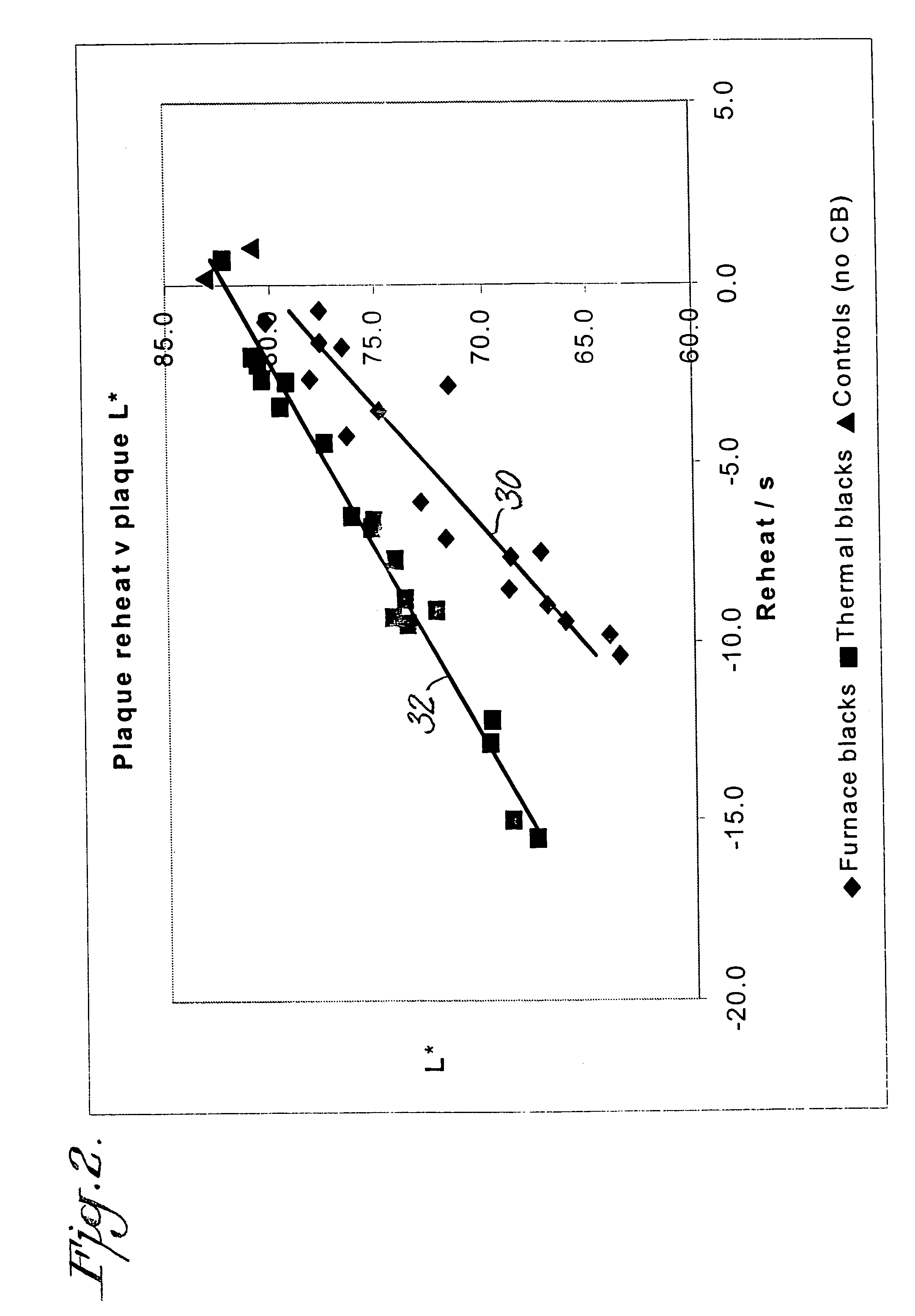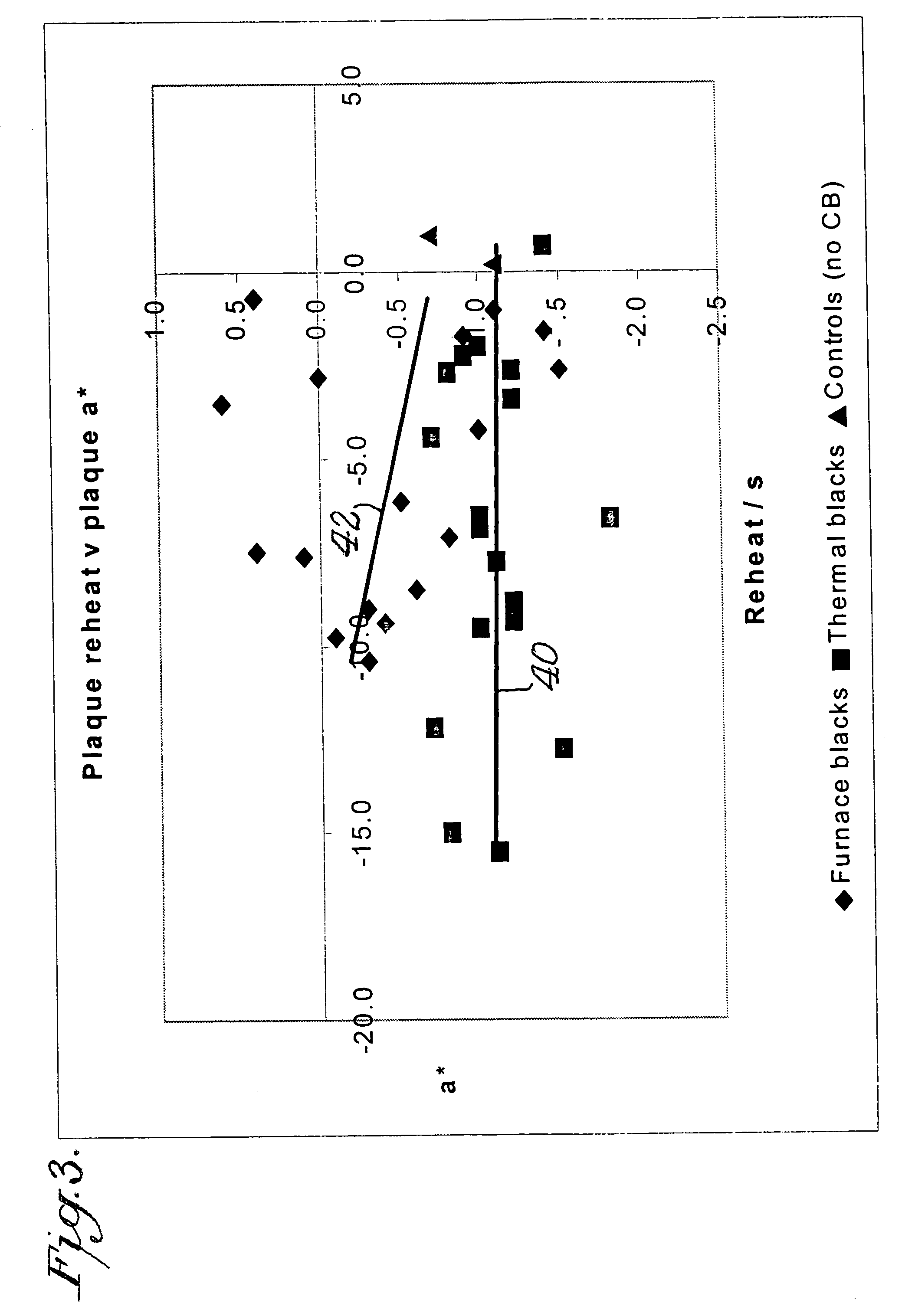Carbon black with large primary particle size as reheat additive for polyester and polypropylene resins
a polypropylene resin and additive technology, applied in the direction of non-metal conductors, conductors, other domestic articles, etc., can solve the problems of reducing the reheat efficiency of pet resins, reducing the reheat efficiency of preform heating and stretch blow molding, and reducing the reheat efficiency of preform heating and stretching. the effect of reducing the reheat rate and improving the reheat characteristics of pet resins
- Summary
- Abstract
- Description
- Claims
- Application Information
AI Technical Summary
Benefits of technology
Problems solved by technology
Method used
Image
Examples
example 1
Polyethylene Terephthalate
[0044]Base polymer PET samples to demonstrate the present invention were made on a 70 Kg scale batch reactor. This consists of two separate stirred vessels, the first for the direct esterification of terephthalic acid with ethylene glycol under high pressure to produce the “monomer” and the second for the polymerisation of the monomer under vacuum (hereinafter referred to as the “autoclave”). With the exception of the carbon black reheat additive, all the samples in this example were made with identical formulations and under identical process conditions.
[0045]59.3 Kg of terephthalic acid, 1.2 Kg isophthalic acid and 29.0 Kg of ethylene glycol were charged to the esterification vessel and reacted at 250 C and at 40 pounds per square inch above atmospheric pressure until 9 liters of water had been removed from the reaction mixture. The vessel was then restored to atmospheric pressure and 10.5 g of phosphoric acid added and stirred into the monomer to act as ...
example 2
[0058]PP compositions to demonstrate the present invention were prepared by compounding different types of carbon black into RE420MO polypropylene made by Borealis. 5 ml of liquid paraffin was added to 5 kg of the PP granules in a bag blender that was then tumbled to coat the granules with a thin film of paraffin. The carbon black was added to the coated granules in an amount to give the desired concentration in the final composition and the bag tumbled again to ensure an even adhesion of carbon black. The coated granules were then compounded through an APV MP2030 twin screw extruder, where the extrudate was quenched and re-cut into granules. This intermediate material was compounded again through a Boston-Matthews single screw extruder fitted with a 4-section Cavity Transfer mixer at the outlet. The extrudate was again quenched and cut into granules to provide the final composition.
[0059]Plaques were moulded from these compositions on a Krupps KR35 extruder in the same...
example 3
Polypropylene Preform Blowing
[0062]To demonstrate the present invention in a typical bottle process, a PP preform blowing experiment was performed using preforms moulded from two of the compositions described above, one containing a Furnace carbon black and the other containing a Thermal carbon black. In order to quantify the reheat advantage conferred by the different blacks the experiment was set up to measure the reduction in the preform heat up time possible whilst maintaining satisfactory blowing of the bottles.
[0063]The experiment was carried out using 23 g weight preforms from which 500 ml volume bottles were blown. The preforms were injection moulded under typical PP injection moulding conditions at a melt temperature of 220 C and mould temperature of 15 C on a single cavity injection mould machine. A separate laboratory blowing machine made by SIPA and specifically designed for the production of PP bottles, was then used to blow the bottles. The blowing machine had two infr...
PUM
| Property | Measurement | Unit |
|---|---|---|
| diameter | aaaaa | aaaaa |
| diameter | aaaaa | aaaaa |
| diameter | aaaaa | aaaaa |
Abstract
Description
Claims
Application Information
 Login to View More
Login to View More - R&D
- Intellectual Property
- Life Sciences
- Materials
- Tech Scout
- Unparalleled Data Quality
- Higher Quality Content
- 60% Fewer Hallucinations
Browse by: Latest US Patents, China's latest patents, Technical Efficacy Thesaurus, Application Domain, Technology Topic, Popular Technical Reports.
© 2025 PatSnap. All rights reserved.Legal|Privacy policy|Modern Slavery Act Transparency Statement|Sitemap|About US| Contact US: help@patsnap.com



